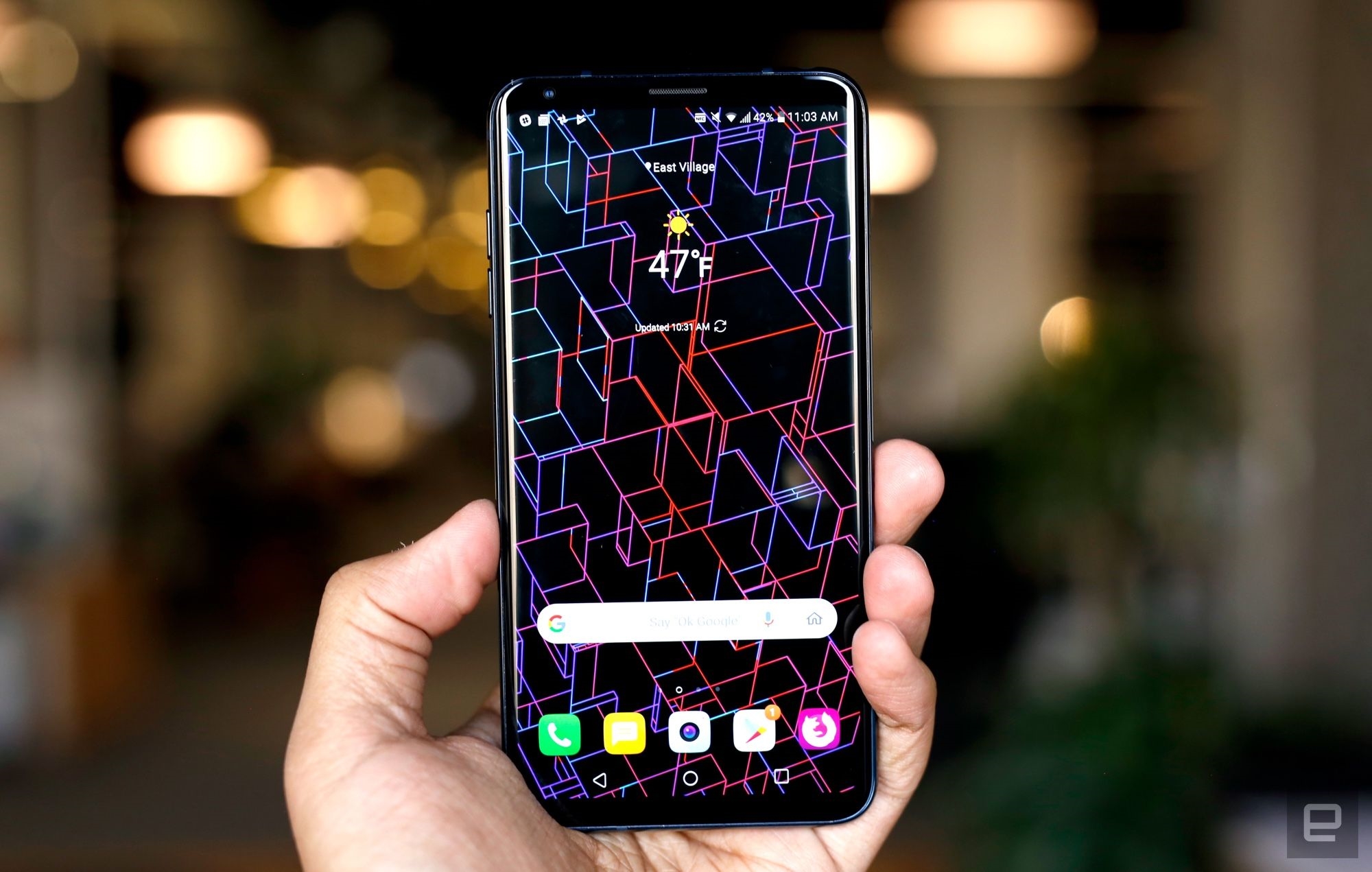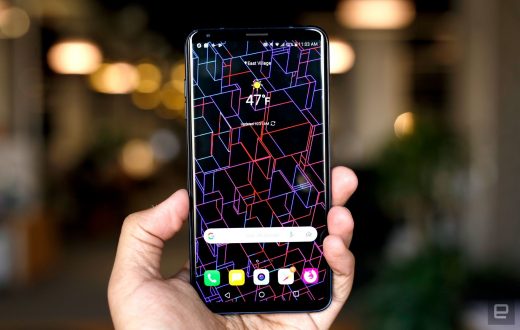LG V30S ThinQ review: A solid but pointless phone

It had its fair share of flaws, but last year’s LG V30 might have been the finest phone the company had made to date. Rather than wait the usual year for an official sequel, though, LG decided to spice things up a bit by unveiling a tweaked version of the phone at Mobile World Congress. Interestingly, the AI-fueled camera features that make the new V30S ThinQ special will also wind up on the original, rendering most arguments for buying this updated model moot. Despite being a perfectly solid smartphone with some notable improvements over the original, I can’t help but think the V30S ThinQ is ultimately pointless.
Oh, and one more thing before we dive in: This isn’t a typical review. We received this preproduction V30S ThinQ during the tail end of MWC, and it’s running a Korea-specific build of Android 8.0 Oreo. It’s been enough to get a feel for what the V30S experience is all about, but we’ll update this story with firmer conclusions when a retail-ready US model becomes available. Actually, I should say “if” a US model becomes available: The phone is already available for a hefty sum in its native South Korea, but with the G7’s global launch coming quickly, it’s possible we won’t see the V30S in the US at all.
Honestly, though, the V30S ThinQ barely counts as a new phone. Its physical design is unchanged, other than some new colors. (The Moroccan Blue finish is pretty spectacular.) Its internals have been given a minor update — there’s 6GB of RAM and either 128 or 256GB of storage — but the fundamentals remain the same. And the super-flexible dual camera functions the same way it always has, just with a pair of new image-recognition features and some specific new Google Assistant commands. “ThinQ” is not only an unfortunately spelled buzzword but also LG’s way of calling out the threads of artificial intelligence that make the V30S notable.
When you’re not using that AI-augmented camera (which I’ll get into more later), this phone feels identical to last year’s V30. The extra 2GB of RAM haven’t made an immediately noticeable difference in how well the phone runs, and despite being one generation behind the curve, the Snapdragon 835 chipset inside still means that it’s not a problem to jump between apps and playing games like PUBG Mobile. And since the battery hasn’t changed at all either, you can generally expect a little more than a full day of usage from a single charge. That’s not to say there are no differences though.
For some reason, Chrome ran absolutely terribly on the V30S. It didn’t matter which website I attempted to visit or when or what wireless network the phone was connected to. Scrolling down the feed of articles on Engadget or anything else was sluggish and jerky to the point where I nearly gave up on browsing entirely and just used the phone as a hi-res music player. To date, LG says it hasn’t run into similar issues on other devices, so I’m willing to chalk this up to preproduction bugs.
And speaking of production issues, it seems like LG’s early V30 screen problems have been worked out. Well, to an extent anyway. One of the biggest strikes against the company’s late-2017 flagship was that some units had screens that looked dingy and uneven in low light. It was especially noticeable when I used the V30 to read Kindle books in bed. Our V30S ThinQ isn’t exactly perfect — the screen still seems kind of gritty if you look closely enough — but it’s much better than the mess I got the first time around.
The real appeal here is the camera. With the original V30, LG put together a remarkably capable dual-sensor system that impressed because of its video chops. I’m nothing special as a video producer, but the laundry list of features (granular manual controls, focus peaking, the ability to shoot flat Cinelog footage for easier postproduction color grading, etc.) is more complete than any other phone we tested in 2017. Thankfully, that all remains true of the V30S ThinQ too.
The V30 wasn’t a bad stills camera either: Switching between the 16-megapixel telephoto camera (with a then-industry-leading f/1.6 aperture) and the 13-megapixel wide-angle camera made it surprisingly flexible. When it came to purely off-the-cuff photography, though, the V30 was pretty easily outgunned by devices like Samsung’s Galaxy S8 series and both of Google’s Pixel 2s. The Pixels in particular set the standard for mobile photography last year, thanks to the backend computational tuning that automatically improves photos as soon as you take them. We’ve reached the point where getting a great photo doesn’t just boil down to sensor specs and fine-grained controls — a dash of artificial intelligence definitely helps.
LG’s adoption of that idea is the reason the V30S ThinQ exists. Rather than automatically tune photos after they’re taken, LG’s new AI Cam feature tries to identify whatever’s in front of the camera so it can fire up the appropriate scene mode. The AI Cam can choose among eight modes, and it was almost always dead-on. Pointing the V30S at a person’s face kicked off “portrait” mode consistently while pets and urban landscapes also correctly triggered their corresponding presets.
It’s somewhat limited though. The phone was quite good at figuring out when to turn on “food” mode, for instance, but it augmented photos of different food items the same way. The intelligence on display here only extends as far as object identification — the tweaks made to portraits, landscapes and photos of pets were apparently locked into each preset and were the same every time. ASUS, Huawei and still other companies have embraced a similar approach, so there’s nothing novel here, but it works well enough. And if nothing else, watching keywords bubble up on the screen while the camera tries to figure out what it’s looking at is fascinating the first few times it happens.
Then there’s QLens, which ultimately isn’t much more than a pared-down version of Bixby Vision. Once it’s enabled, you’re given the option to snap a photo of an object and search for related results on Amazon and Pinterest. I’ve been dreaming for years now of an app that would help me identify shoes, accessories and articles of clothing I see around New York that I’d want to add to my collection and this … definitely isn’t it. Having Amazon as a search partner for retail results is awfully handy, but the V30S ThinQ was never very accurate. Unless the item is very clearly labeled or exceptionally unique in its design, you’re probably not going to get the right result. It’s also worth noting that if/when the V30S ThinQ arrives in the US, it might not have Amazon as a search partner: Samsung had a similar partnership with Amazon last year, but that seems to have fallen apart.
QLens’ Pinterest integration worked a little better, but there’s little value here unless you’re a die-hard Pinhead. Sure, taking photos of clothing often returned results that looked pretty similar. I just don’t find adding those images to a pinboard particularly helpful. Your mileage may vary, naturally.
Oh, and while it’s not actually connected to LG’s AI endeavors, the new Night mode generally works like a treat too. Long story short, it treats four pixels on the main camera as one, resulting in brighter, lower-resolution shots (you might know this better as pixel binning). The quality-brightness trade-off can be worth it if you don’t require high-res results, say, for printing, but it would’ve been nice if this feature worked on both of the V30S’ cameras.

Beyond that, LG also worked with Google to craft new, device-specific Google Assistant commands that let you access specialized camera functions with your voice. They range from the generally useful (“Hey Google, take a wide-angle selfie” or “Hey Google, open the camera in manual mode”) to the absurd (“Hey Google, take a romantic Cine video”). At time of writing there are 23 V30S-specific commands, and most of them are just for launching the video camera with a specific set of Cine effects. The company says it’s working on some more immediately useful commands so that you’ll be able to ask Google to scan a QR code, search for images or take an AI Cam photo, but sadly, none of these have materialized yet.
At the end of my first go-around with the V30S ThinQ, I pondered whether anyone out there should actually drop some hard-earned cash on this thing. After living with the phone for the better part of a month, my answer for just about everyone is a definitive no. The V30S is what LG has referred to in the past as an interim release, a device meant to drive customer interest and keep people talking about LG in between its major flagship devices. It’s not an inherently flawed idea, but we already know LG is making the same AI-fueled features available on the original V30 as well. The point here is clearly to make a little extra scratch without having to significantly modify an existing phone’s production process. As far as money grabs go, this one’s pretty naked.
I’ve had a hard time trying to figure out who exactly this phone is meant for, though I think might have finally cracked it: It’s perfect for the irredeemably impatient. We’re this close to getting our first real look at LG’s G7 flagship, and there’s no question the AI features that debuted on the V30S ThinQ will appear on that device too. For now the only seemingly serious value in owning this updated V30 is getting to test some of those features first, and I can’t imagine many people are clamoring for that honor. I still think the V30S ThinQ is a great phone, and that’s not just because of my lingering fondness for the original. But does this thing actually need to exist? Not at all.
(23)



